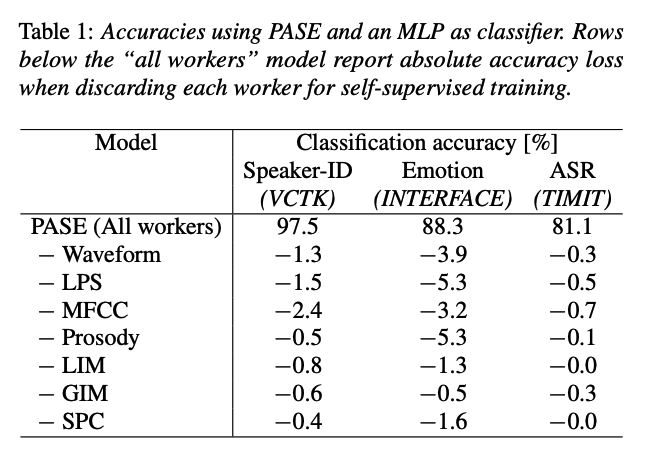Learning Problem-agnostic Speech Representations from Multiple Self-supervised Tasks ( arxiv 2019 )
https://arxiv.org/pdf/1904.03416.pdf
Contents
- Abstract
- Introduction
- PASE (Problem-agnostic Speech Encoder)
- Encoder
- Workers
- Self-supervised Training
- Ablation study of workers
Abstract
PASE: self supervised method
- single encoder is followed by multiple workers
- multiple workers = jointly solve different self-supervised tasks
Experiments
- carry on relevant information from the speech signal, such as speaker identity, phonemes, and even higher-level features such as emotional cues.
1. Introduction
Challenges of speech signals
- high-dimensional, long, and variable-length sequences
- entail a complex hierarchical structure
- that is difficult to infer without supervision (phonemes, syllables, words, etc.).
- Thus hard to find a single self-supervised task that can learn general and meaningful representations able to capture this latent structure.
Solution : propose to jointly tackle multiple self-supervised tasks using an ensemble of neural networks
- intuition : each self-supervised task may bring a different view or soft constraint on the learned representation.
- requires consensus across tasks, imposing several constraints into the learned representations.
\(\rightarrow\) proposed architecture = problem-agnostic speech encoder (PASE)
- encodes the raw speech waveform into a representation
- fed to multiple regressors and discriminators ( = workers )
- Regressors = deal with standard features computed from the input waveform
- resemble a decomposition of the signal at many levels.
- Discriminators = deal with either positive or negative samples
- trained to separate them by minimizing BCE loss
- Regressors = deal with standard features computed from the input waveform
2. PASE (Problem-agnostic Speech Encoder)

PASE architecture
- (1) fully-convolutional speech encoder
- (2) 7 multilayer perceptron (MLP) workers
(1) Encoder
a) 1st layer = SincNet model
- performs the convolution of the raw input waveform with a set of parameterized sinc functions that implement rectangular band-pass filters.
- interesting property = the number of parameters does not increase with the kernel size
- use a large kernel width \(W=251\) to implement \(F=64\) filters with a stride \(S=1\).
b) 2nd layers = stack of 7 convolutional blocks
- each block employs a 1D convolution, followed by BN
- multi-parametric rectified linear unit (PReLU) activation
- details (of 7 blocks)
- kernel widths \(W=\{20,11,11,11,11,11,11\}\)
- filters \(F={64,128,128,256,256,512,512}\)
- strides \(S=\) \(\{10,2,1,2,1,2,2\}\).
c) 3rd layer = convolution with \(W=1\)
- projects 512 features to embeddings of 100 dim
- non-affine BN layer
(2) Workers
7 self-supervised tasks
-
regression or binary discrimination tasks
-
workers are based on very small feed-forward networks
-
composed of a single hidden layer of 256 units with PReLU activation
(the only exception is the waveform worker, see below).
-
-
encourage the encoders to discover high-level features
Regression workers
-
break down the signal components at many levels in an increasing order of abstraction
-
trained to minimize MSE
(again the waveform worker is an exception)
4 Regression workers
- (1) Waveform
- predict the input waveform in an auto-encoder fashion
- (exception) Decoder
- Three deconvolutional blocks
- with strides 4,4 , and 10 that upsample the encoder representation by a factor of 160
- MLP of 256 PReLU units is used with a single output unit per timestep.
- Three deconvolutional blocks
- (exception) minimize MAE
- Why MAE? as the speech distribution is very peaky and zero-centered with prominent outliers
- (2) Log power spectrum (LPS)
- compute it using a Hamming window of \(25 \mathrm{~ms}\) and a step size of \(10 \mathrm{~ms}\), with 1025 frequency bins per time step.
- (3) Mel-frequency cepstral coefficients (MFCC)
- extract 20 coefficients from 40 mel filter banks (FBANKs).
- (4) Prosody
- predict four basic features per frame, namely the interpolated logarithm of the fundamental frequency, voiced/unvoiced probability, zero-crossing rate, and energy ( = called “Prosody” )
Discrimination workers
- 3 binary discrimination tasks
- learning a higher level of abstraction than that of signal features
- rely on a pre-defined sampling strategy
- draws an anchor \(x_a\), a positive \(x_p\), and a negative \(x_n\) sample from the pool of PASE-encoded representations
- reference \(x_a\) = an encoded feature extracted from a random sentence
- negative & positive = drawn using the different sampling strategies described below
- draws an anchor \(x_a\), a positive \(x_p\), and a negative \(x_n\) sample from the pool of PASE-encoded representations
- Loss function :
- \(L=\mathbb{E}_{X_p}\left[\log \left(g\left(x_a, x_p\right)\right)\right]+\mathbb{E}_{X_n}\left[\log \left(1-g\left(x_a, x_n\right)\right)\right]\).
- where \(g\) is the discriminator function
- \(L=\mathbb{E}_{X_p}\left[\log \left(g\left(x_a, x_p\right)\right)\right]+\mathbb{E}_{X_n}\left[\log \left(1-g\left(x_a, x_n\right)\right)\right]\).
- Notice that the encoder and the discriminators are not adversarial here, but must cooperate!
Sampling POS & NEG
- Local info max (LIM)
- Global info max (GIM)
- Sequence predicting coding (SPC)
(3) Self-supervised Training
Encoder and workers
- jointly trained with backpropagation
- total loss = average of each worker cost
Gradients of encoder
- gradient coming from the workers are thus averaged
To balance the contribution of each regression loss….
- we standardize all worker outputs, before computing the MSE
3. Ablation study of workers

